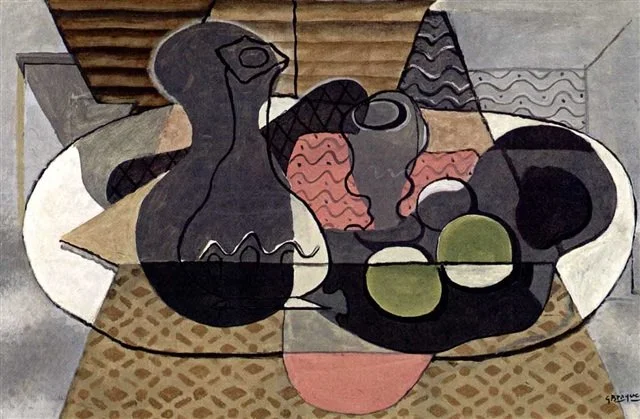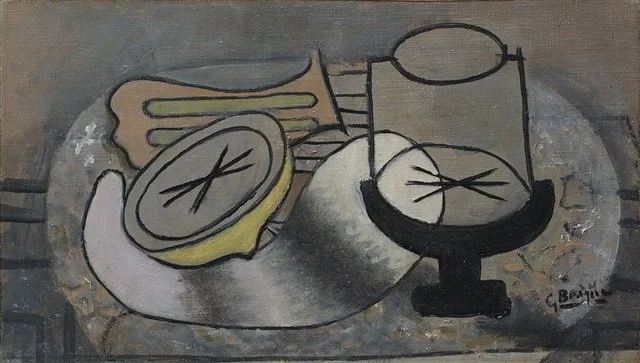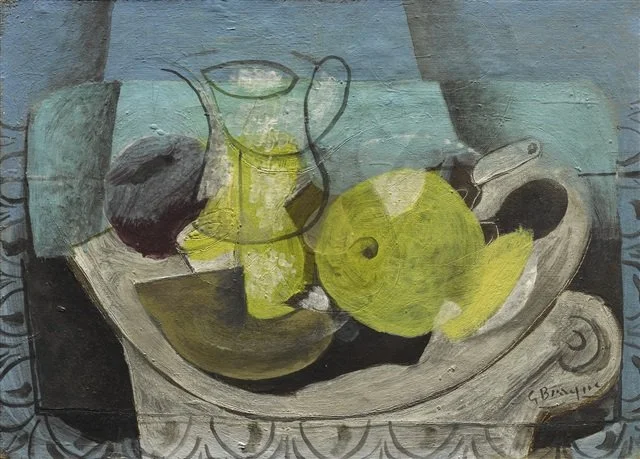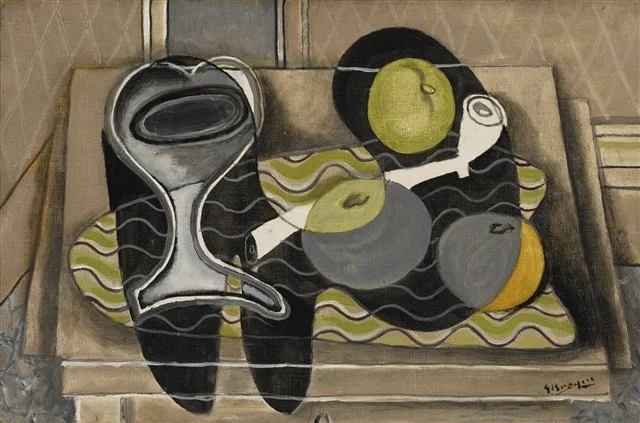GEORGES BRAQUE,
LE PLAT DE FRUITS, 1941
GEORGES BRAQUE
Le Plat de Fruits
signed, lower right GBRAQUE
certificate signed by Quentin Laurens
oil on paper mounted on canvas
18.9 x 25.2 in. / 48 x 64 cm
painted in 1941
Provenance:
● Galerie Louise Leiris, Paris
Exhibited:
● Georges Braque, La Nueva Pesa, Rome, May 1974 catalog illustration No 4
COMPARATIVE PAST AUCTIONS
-
Georges Braque, Carafe, verre et fruits
Medium : oil on canvas
Year of Work : 1931
Size : Height 19.7 in.; Width 28.7 in. / Height 50.1 cm.; Width 73 cm.
Signed
Sale of : Sotheby's New York: Thursday, November 4, 2004 [Lot 00047]
Impressionist and Modern Art (Evening)
Estimate : 500,000 - 700,000 USD
Sold For : 512,000 USD Premium
source : ARTNET.COM -
Georges Braque, Le citron
Medium : oil on canvas
Year of Work : 1934
Size : Height 7.6 in.; Width 13 in. / Height 19.2 cm.; Width 33 cm.
Signed
Sale of : Christie's Paris: Friday, October 18, 2019 [Lot 00108] Art Moderne
Estimate : 70,000 - 100,000 EUR (78,098 - 111,569 USD)
Sold For : 200,000 EUR Premium (223,139 USD)
Provenance :
Private collection, France.
Then by descent to the current owner.
source : ARTNET.COM -
Georges Braque, Pichet et fruits
Medium : oil on canvas
Year of Work : 1935
Size : Height 9.4 in.; Width 13 in. / Height 23.8 cm.; Width 33 cm.
Signed G Braque (lower right)
Sale of : Sotheby's New York: Wednesday, May 17, 2017 [Lot 00146] Impressionist & Modern Art Day Sale
Estimate : 250,000 - 350,000 USD
Sold For : 492,500 USD Premium
Provenance :
Galerie Zak, Paris
Acquired from the above by 1963
source : ARTNET.COM -
Georges Braque, Nature morte à la pipe
Medium : oil on canvas
Year of Work : 1932
Size : Height 10.6 in.; Width 16.1 in. / Height 27 cm.; Width 41 cm.
Signed
Sale of : Sotheby's New York: Tuesday, May 15, 2018 [Lot 00152] Impressionist & Modern Art Day Sale
Estimate : 400,000 - 600,000 USD
Sold For : 519,000 USD Premium
Provenance :
Private Collection, Berlin
Mrs. Alexandra Whitney, New York Mr. Harry P. Whitney, New York
Paul Rosenberg & Company, New York William Zierler, Inc., New York
Acquired from the above in 1972
source : ARTNET.COM
Carafe, verre et fruits
Le citron
Pichet et fruits
Nature morte à la pipe
source : ARTNET.COM
DOCUMENTATION
GEORGES BRAQUE, Le Plat de Fruits, 1941
In this 1941 work, colour becomes a subject matter unto itself, a move which puts Braque’s painting in keeping with the works of Henri Matisse and Paul Cézanne; their intention was to ‘make art through colour’.
The painting contains several features characteristic of Modern Art; in particular, we will note the glaring gap between how colour looks in reality and how it functions on the canvas. Moreover, Braque’s use of block colours in the background accentuates both the flatness of this painting’s layout and its frontal nature. Meanwhile, the effect of perspective diminishes. The blacks, and greys of varying darkness, contrast with warmer colours such as mauve, yellow, light green and brown. In this way, we start to bear witness to an empowerment being afforded to colour; it is no longer mimetic here, freed from the constraints of realism. It is worth noting that Georges Braque – before his Cubist era – was a key f igure in Fauvism, contributing to this heightened importance of colour throughout his body of work.
Admittedly, Braque does not do away with reality completely here, but he is also not afraid to experiment with the expressive capacity that painting can have as a medium. The intensification of colour in this work attests to that, as does the simplified sketching. For example, the fruit is drawn using spirals, whilst the dish – it could as well be a fruit bowl – is brushed with a few, noticeable grey, black and white lines. The artist’s strokes remain significant on the canvas, giving it a physical, textural quality.
The black form on the left-hand side could be a flower pot or a sculpture – the viewer cannot be totally sure. In the background, geometric decorations not unlike those by Henri Matisse create a sense of stability and balance within the painting.
In the foreground, the objects and the table on which they sit are seen from above, whilst the rest of the elements are seen from the front. These two, contrasting perspectives – shown simultaneously – cannot help but remind us, albeit subtly, of Braque’s Cubist background.
The spirals creating the fruit and the curved lines within both the dish and the table create a gentle harmony on the canvas. These shapes, both to-the-point and delicate, leave no trace of the act of drawing that went into them. Through its coloured surfaces, Le plat de fruits fully reintegrates the role – and emotive power – of colour.
Georges Braque’s Post Cubist Masterpieces, Anthem Edition, 2024.





